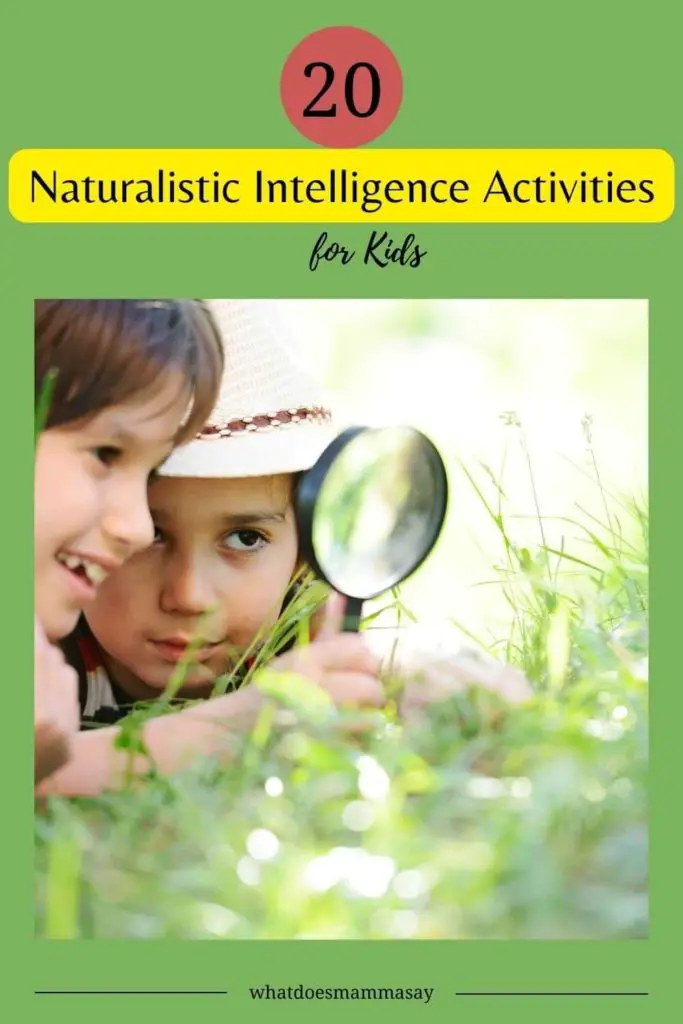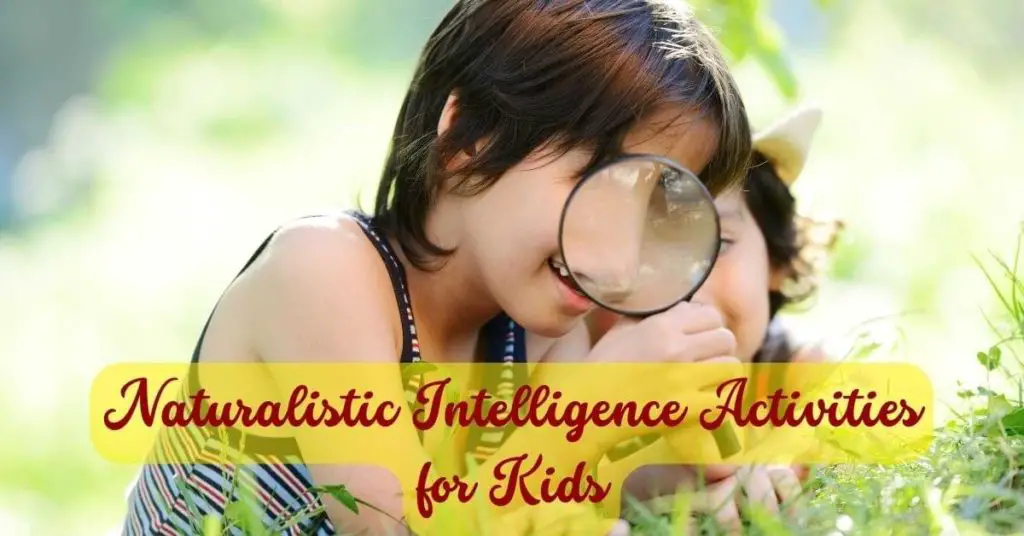In this post, you will discover some of the characteristics of a naturalistic learner, along with 20 naturalistic intelligence activities that will help children refine this ability and some valuable tips on how to teach children with this type of intelligence.
In 1983, American developmental psychologist, Howard Gardner, outlined what was to become a revolutionary idea in his book, “Frames of Mind: The Theory of Multiple Intelligences”.
He suggested that people rely on other abilities (or intelligences as he calls them) besides the Verbal-Linguistic and Logical-Mathematical to make sense of the world around them. He initially identified 7 intelligences, however, the naturalistic intelligence was added to the list in 1999.
Interestingly enough, some people consider that there are 9 intelligences if we are to consider the Existential one, however, Gardner has answered in a published article in 2020 “Sorry, no, it’s still in limbo).
The 8 official intelligences are:
- Verbal-linguistic Intelligence
- Visual Spatial Intelligence
- Intrapersonal Intelligence
- Interpersonal Intelligence
- Logical Mathematical Intelligence
- Kinesthetic Intelligence
- Naturalistic Intelligence
Today we are going to talk about the naturalist intelligence, its characteristics, tips on how to help a nature smart child and some naturalistic intelligence activities.
This post may contain affiliate links and I may earn a small commission when you click on the links at any additional cost to you. As an Amazon Affiliate, I earn from qualifying purchases. You can read my full disclosure here.
What is naturalistic intelligence?
As the name suggests people with this type of intelligence are interested in anything to do with nature and living things.
Thus, a nature smart person is in tune with one’s natural environment, curious and eager to learn about anything to do with nature.
Naturalist intelligence can take many forms like an interest in the weather forecast, gardening, cooking, working with/healing animals, classifying plants, landscape design etc.
What are the characteristics of a nature smart child?
As I have mentioned in other posts on The Multiple Intelligences, we might be born with a predilection towards one or two intelligences but we can also develop an ability throughout our lives. For example, doing many naturalistic intelligence activities will enhance this ability in a person who wasn’t born with it (this goes for all the other intelligences as well).
A person with nature smart intelligence will exhibit some of these characteristics:
- They like spending time outside
- They are interested in the environment
- They want to keep the environment clean so they will get involved in recycling
- They have a desire to understand how things work
- They like exploring and discovering fauna and flora
- They enjoy taking care of plants and animals
- They like using scientific gadgets like binoculats, microscopes, telescopes
- They enjoy reading nature magazines and watching nature documentaries
- They may be interested in taking specific courses like botany or zoology
- They may be interested in joining nature clubs
Considering these traits, a person with naturalistic skills may opt to become a vet, a scientist, gardener cook, landscape designer, farmer, meteorologist, astronomer, conservationist etc.
Naturalistic intelligence activities for kids
Whether your child was born with a naturalist intelligence or you want to develop this ability, here are 20 activities for naturalistic intelligence for kids of all ages.
1. Go on Nature walks
A naturalistic learner will love exploring the great outdoors whenever possible. So, it’s a good idea to take them for a walk in the forest, on a mountain trail, by a river, even a big park will be enjoyable.
2. Start a garden and take care of the plants

There is something so satisfying about taking care of a plant and watching it grow. This is surely an activity that would bring a lot of joy to a nature smart child.
Children with this type of intelligence might be interested in more than just planting the seeds and watering the plants. They might want to learn about the different types of soil and which plant will thrive in a particular soil mixture. Also, they will want to know the best way to care for different plants, like how often to water them, where is the best place for them (a shady place, full or partial sun etc), the best fertilizer, and get some special gardening tools.
3. Keep a plant/animal journal
Keeping journals is not only fun but it also helps its owner learn many things about the object(s) of study.
A great naturalistic intelligence activity is to start a journal about certain plants (this could go perfectly with starting a garden) or animals.
For a plant journal organize the pages into categories like care schedule (watering, fertilizing, rotating, pruning etc), problems the plant may have, growth patterns, thoughts and observations and pages on which drawings, photos or stickers are added.
Similarly, organize an animal journal for a pet or an outside animal that you want to observe. Write details about the animal’s appearance (also add drawings or pictures), its habits, habitat, what it likes to eat, your thoughts etc.
4. Watch nature documentaries
Another way of learning about nature is by watching documentaries. A child with a naturalistic learning style will not only thoroughly enjoy a nature documentary but you can be sure that s/he will learn many things from it.
There is a wealth of documentaries out there and you can find them on Youtube, Netflix, Amazon Prime Videos, dedicated channels on the TV and online. Websites like National Geographic Kids or Switch Zoo (contains animals games) are fun, interesting and presents the information in a way that can be “digested” by kids.
And, my personal favourite, the documentaries by Sir David Attenborough which are absolutely breathtaking. Here is a top 10 of the Best Documentaries to Watch by Sir Attenborough.
5. Make a herbarium
A herbarium is like a book but instead of words it has preserved plants. Making a herbarium would be a wonderful project for a little naturalistic learner.
You can make your own herbarium from an A4 (or bigger if you have) notebook or buy a ready-made one.
It will be so exciting for kids to select the plants, press them and then carefully glue them in the notebook. Don’t forget to make notes about the plant as well.
Here is a little guide on how to start a herbarium for kids.
6. Volunteer at your local animal shelters
Volunteering is a great opportunity for kids to have a sense of purpose, to learn appreciation, build social skills, learn different life skills and so many other beneficial things.
A good naturalistic intelligence activity would be to volunteer at a local animal shelter. Children will be able to bring their contribution to improving animals’ life and also to get experience from working with them.
7. Make a bird feeder
By making a bird feeder you will not only be able to observe the beautiful birds living in the area but you will also be helping them a lot by supplementing their natural food sources.
A DIY bird feeder is really not difficult to make, you don’t need fancy materials or special skills. Take a look here at these 32 easy bird feeder crafts for inspiration.
If DIY isn’t your thing, then you can buy beautiful ready-made bird feeders. Just put in the seeds and it’s good to go.
8. Visit a conservation park
Conservation parks are large areas of land that are protected by law along with all the fauna and flora found there.
Visiting such a park would be a great opportunity to observe unspoilt nature and teach kids the importance of preserving our environment.
9. Play with “nature’s toys”

Have you ever noticed that sometimes you buy your children a nice toy only for them to play with the box? Many kids prefer uncomplicated toys that allow them to use their imagination and creativity (see our post on Open-Ended Toys and Materials).
Nature offers some awesome toys for kids and the best part is that they are free. They will love playing with pebbles, sticks, shells, mud, leaves, pine cones, seeds, logs, acorns etc.
10. Take care of pets
Taking care of pets teaches children valuable lessons like responsibility, empathy, respect for nature, not to mention that the pet provides comfort and companionship.
A child with naturalistic intelligence, in particular, will enjoy this activity.
11. Observe nature with a scientific tool
Using scientific tools like microscopes, telescopes and binoculars is a fantastic way of allowing naturalistic learners to observe nature up close. Encourage them to make notes or talk about the things that they observe.
12. Visit an aquarium
Sea life is absolutely mesmerizing. There is something so soothing watching the fish glide in their environment.
It’s also a great opportunity for kids to learn about the different types of fish and mammals living in our seas and oceans as well as what we can do to protect them.
13. Write an essay on a burning nature topic
This is a good naturalistic intelligence activity for older children who can write and organize their ideas well enough for an essay.
Writing an essay on hot topics like global warming, protecting endangered species or reducing waste is a great opportunity for kids to express their opinion on these issues.
There is a multitude of topics that the little naturalistic learners can share their views on, from the trickiest ones (like the ones mentioned above) to day-to-day topics like how to keep your pet happy.
Writing essays, besides refining a very important skill, gives kids a voice and a way of sharing their worldview. You can even try to publish the work on one of the many websites that accept children’s writings.
14. Go camping

One of the best naturalistic intelligence activities that you can do is going camping. There are so many benefits to camping like seeing animals in their natural habitats, learning basic survival skills, respecting nature, relieving stress and the list goes on.
A nature smart child will particularly enjoy this activity as he will feel at home amidst nature.
15. Visit a local farm
The best way for kids to learn about domestic animals and all the work that goes into caring for them is not reading about it in a book but actually visiting a farm.
There are lots of farms that allow visitors and have special activities for kids. Just search for them online or ask around.
16. Read books and encyclopedias about nature
A naturalistic learner’s interest in the environment often goes deeper so they have a desire to learn more about certain topics related to the natural world.
Encourage them to read books and encyclopedias on different topics like animals, the human body, dinosaurs, space, plants etc.
The beautifully illustrated books are attractive for kids and make learning fun and exciting.
17. Recycle
Since kids with a developed naturalistic intelligence are interested in the environment they will also be eager to help preserve it.
Thus, recycling will be an activity that they will enjoy doing. All kids, regardless of their dominant intelligence, should be introduced to recycling early on and be encouraged to reduce the human impact on nature.
18. Collect unusual natural objects (feathers, rocks, leaves etc)
Nature is the best artist and we often marvel at some of its beautiful and unique creations. Collecting natural objects is one of the best naturalistic intelligence activities and one that will foster curiosity, attention, patience and ultimately pride in achieving something special.
The collection can contain any natural objects that the child finds interesting: shells, pebbles, feathers, leaves, sticks, pine cones, chestnuts etc.
19. Make a terrarium

First of all, what is a terrarium? Basically, it is a miniature garden inside a jar or glass bowl. All you need for this project is a bowl, soil, fun decorations (pebbles, toys), and small plants like cacti, ferns, succulents.
You can choose to make an open terrarium which you will have to take care of and water or a sealed one which is pretty much a self-sustaining ecosystem.
Here is a post that tells you how to make a simple, DIY terrarium.
20. Have a picnic outside
Kids with a nature smart intelligence love spending time outdoors. The more the better. So, whenever possible, organize a picnic outside. It doesn’t even have to be far away from home, the garden or even the balcony will do just fine.
In addition to being fun and exciting, a picnic may spark an interest in eating for those fussy kids. It’s worth trying.
Tips on teaching a child with a naturalistic learning style
Each child has his/her own way of retaining information so adapting the way in which we, as teachers or parents, present that information will positively impact the learning process.
Here are some tips on how to teach children with a naturalistic learning style:
- Take learning outside whenever possible with visits to museums, parks, historical sites.
- When teaching History, talk about natural occurances during certain historical events like meteorological events thay took place around that time or perhaps some details about the
- As much as possible, link various school subjects to the natural environment. For example, when teaching History, talk about natural occurances during that particular historical period like meteorological events or perhaps some details about the landscape. Or when teaching Mathematics, link some of the concepts to nature like shapes, patterns, symmetry, the Fibonacci sequence.
- Like kinesthetic learners, students with a nature smart intelliegence will benefit from hands-on experiences rather than reading the information from a book.
- Ensure that they have as much outdoors time as possible.

Final Thoughts
Kids with naturalistic intelligence have a real connection to nature so they will thrive when they are allowed to pursue interests like hiking, collecting natural objects, reading or watching documentaries, caring about animals and plants, getting involved in environmental projects etc.
Nature smart children will amaze you with their ability to distinguish between different types of plants, to remember scientific names and facts and to notice things about the environment that someone with different types of intelligences might not.
Having said this, a person who hasn’t got a developed naturalist intelligence can expand it by doing specific activities like the ones above.
Considering the amount of screen time kids get nowadays, it wouldn’t be a bad idea to encourage more outdoor activities and learning
I hope that these naturalistic intelligence activities will be useful so be sure to share this post with others who might find it interesting 🙂
Also, check out other articles on Multiple Intelligences:
Fun Activities for the Verbal-Linguistic Learner
The Best Activities for the Logical-Mathematical Intelligence
Musical Intelligence Activities for Auditory Learners
Activities for Kids with Intrapersonal Intelligence
Fun Activities for the Bodily-Kinesthetic Learners
Activities for the Visual-Spatial Learner
How Can The Multiple Intelligences Theory Help Your Child?
Emotional Intelligence Activities for Kids

Mom of two wonderful children, dedicated teacher and book lover.











I’ve never heard about this form of intelligence before, so this is very useful for me! Both my daughters are definitely born with the naturalist intelligence. They love outdoors, like to dig dirt everyday in the garden (even when it’s freezing cold), so this list of activities will come in handy some day. I’d like to steer them away from screen time as much as possible, and reserve TVs for rainy days/ emergencies when I can’t take them out. Thanks for sharing!
Loved your post. My child loves spending time in nature, found interesting ideas in this post. It’s really helpful.
My toddler loves to do gardening and yard work with his Dad!
This was a great post to read. I am so happy that weather is starting to warm up and my son and I can spend more time outdoors enjoying the sun and nature! I will definitely come back to this post in the future for ideas 🙂
This is so interesting! I’ll be starting a garden with my daughter this weekend and we’re very excited! Looking forward to some of these other activities you’ve recommended as well 🙂
Thanks for sharing these nature intelligent activities. Will try some with my son.
What an interesting post! I’ve never heard of naturalistic intelligence before. I love all the ideas and tips to get children to use their intelligence. I can’t wait to use some of these this summer!
I had no idea what naturalistic intelligence was before. After reading your article, I learned that my children have naturalistic intelligence. They are very interested in nature and the environment. They are always asking me about different animals and plants. I’m glad to know that there is a name for this type of intelligence.